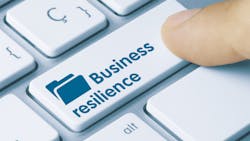Mastering the Art of Business Resilience
Download this article in PDF format.
The global pandemic taught most companies a valuable lesson in business resilience, or the ability to adapt quickly to disruptions while also maintaining continuity of business operations and safeguarding people, assets and overall brand equity. Also known as continuity planning, business resilience ensures that individuals are prepared and educated on how to respond accordingly during chaotic situations.
As evidenced across numerous industries and individual organizations, business resilience was not a core focus for many during the more than 10-year-long run of economic prosperity leading up to 2020. Now, companies are figuring out how to manage the impacts of a lingering, worldwide pandemic while also mapping out their business resilience plans for the future.
Riding Out the Shockwaves
In a new report, Bain & Co. discusses the pandemic-related shockwaves that rippled across the business world and highlights some of the key steps that companies should be taking now to prepare themselves for the next disruption. In “Getting Business Resilience Right,” the management consultancy says that business resilience is “all the rage” right now as companies work to shore up their global supply chains.
As part of this effort, organizations are now beginning to shift their thinking about resilience, and about how their various facets, departments and subsidiaries can work together to create a stronger, more agile organization.
“Even those [companies] that managed to hustle their way through the pandemic on the back of heroic efforts by employees and partners sense that they need a more sustainable approach,” it points out. Getting there isn’t always easy. Here are a few of the top myths that supply chain leaders will likely encounter when attempting to roll out resilience initiatives in 2021 and beyond:
Resilience eliminates volatility. “In current times, the likelihood and consequence of events cannot be forced into a tidy probability distribution,” Bain states, noting that trying to minimize volatility is similar to buying insurance that protects against the deductible (rather than the loss itself). “It misses the bigger objective of ensuring that the inevitable surprises encountered along the way don’t permanently damage a firm’s ability to generate an acceptable return on the capital invested across the cycle,” says Bain.
It’s all about the balance sheet. Not true, says Bain, which points out that resilience spans these five dimensions:
- Strategic, including absolute and relative scale, demand elasticity, revenue and profit diversification and cross-correlations;
- Financial, including leverage and liquidity, but also insurance coverage and hedges;
- Operational, including operating leverage, supplier concentration and redundancy;
- Technological, including availability, workload mobility and cybersecurity; and
- Organizational, including crisis preparedness, organizational agility and personal resilience.
“Adopting a holistic view of resilience acknowledges the reality that external events typically affect companies through several of these dimensions simultaneously, compounding the extent of the shock,” Bain adds. “Accounting for all these dimensions allows executives to make smarter choices about where to invest scarce resources in resilience.”
- Past resilience guarantees future resilience. When it comes to resilience, you can’t just “set it and forget it.” You have to revisit your plans regularly and ensure that they align with both current and future risks. “Once the dust settles from the COVID-19 crisis, most firms will likely be better prepared to deal with the next pandemic, just as banks are better prepared for the next mortgage crisis,” Bain explains, adding that true resilience demands asking “what could happen” that would truly test the business, rather than anchoring on recent experience.
Start Preparing Now
Too often, Bain says risk gets treated as an “obligatory but unfortunate box-checking exercise” that is then relegated to a corner of the organization. Companies embarking on the road to resilience need to know that it will require a commitment from senior leaders and board members, both of which should be involved in the decision-making.
“They might welcome this endeavor as an opportunity to set themselves up for success,” Bain adds. “Who believes that the turbulence of recent years will abate? That seems like very long odds. Those who expect continued or greater volatility will be able to take strong countermeasures only if they start preparing now.”
About the Author

Bridget McCrea
Contributing Writer | Supply Chain Connect
Bridget McCrea is a freelance writer who covers business and technology for various publications.







